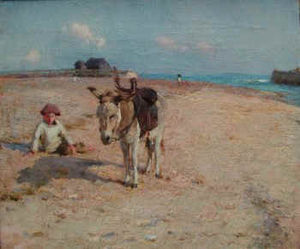
Walter Osborne
Encyclopedia

Irish people
The Irish people are an ethnic group who originate in Ireland, an island in northwestern Europe. Ireland has been populated for around 9,000 years , with the Irish people's earliest ancestors recorded having legends of being descended from groups such as the Nemedians, Fomorians, Fir Bolg, Tuatha...
impressionist landscape and portrait painter. Most of his paintings featured women, children, and the elderly as well as rural scenes.
Career
Walter Osborne was born in RathminesRathmines
Rathmines is a suburb on the southside of Dublin, about 3 kilometres south of the city centre. It effectively begins at the south side of the Grand Canal and stretches along the Rathmines Road as far as Rathgar to the south, Ranelagh to the east and Harold's Cross to the west.Rathmines has...
, Dublin, the second of three sons of William Osborne, a successful animal painter. He was educated at Rathmines School and at the Royal Hibernian Academy
Royal Hibernian Academy
The Royal Hibernian Academy is an artist-based and artist-oriented institution in Ireland, founded in Dublin in 1823.-History:The RHA was founded as the result of 30 Irish artists petitioning the government for a charter of incorporation...
school.
He won the Taylor Prize in 1881 and 1882, the highest student honour in Ireland of the time, while studying at the Koninklijke Academie voor Schone Kunsten in Antwerp. He was influenced by the Flemish painter, Rubens, and the French realist, plain-air painter, Jules Bastien-Lepage
Jules Bastien-Lepage
Jules Bastien-Lepage , was a French naturalist painter, a style related to the Realist movement.-Life and work:...
. In 1883, Osborne moved from Antwerp to Brittany
Brittany
Brittany is a cultural and administrative region in the north-west of France. Previously a kingdom and then a duchy, Brittany was united to the Kingdom of France in 1532 as a province. Brittany has also been referred to as Less, Lesser or Little Britain...
where he painted his famous Apple Gathering, Quimperlé
Quimperlé
Quimperlé is a commune in the Finistère department of Brittany in northwestern France.-Geography:Quimperlé is in the southeast of Finistère, 20 km to the sest of Lorient and 44 km to the east of Quimper...
, now in the National Gallery of Ireland
National Gallery of Ireland
The National Gallery of Ireland houses the Irish national collection of Irish and European art. It is located in the centre of Dublin with one entrance on Merrion Square, beside Leinster House, and another on Clare Street. It was founded in 1854 and opened its doors ten years later...
. Soon after, he moved to England where he worked alongside Nathaniel Hill and Augustus Burke
Augustus Nicholas Burke
Augustus Joseph Nicholas Burke was an artist and a member of the Royal Hibernian Academy .-Biography:Burke was born into the Galway Burkes of Glinsk and was the sixth son of William Burke of Knocknagur, Tuam, Co. Galway. He was born at Waterslade House in the town...
at Walberswick
Walberswick
Walberswick is a village on the Suffolk coast in England, across the River Blyth from Southwold. Coastal erosion and the shifting of the mouth of the River Blyth meant that the neighbouring town of Dunwich was lost as a port in the last years of the 13th century...
.
In 1886 he was elected to the Royal Hibernian Academy and received many commissions for portraits. This was an important source of income, as he had no private means of his own. After his sister died he was involved in looking after her daughter, and his own parents became increasingly financially dependent on him.
In 1892 he returned to Ireland to live in the family residence, and he also had a studio at No. 7 St. Stephen's Green
St. Stephen's Green
St Stephen's Green is a city centre public park in Dublin, Ireland. The park is adjacent to one of Dublin's main shopping streets, Grafton Street, and to a shopping centre named for it, while on its surrounding streets are the offices of a number of public bodies and the city terminus of one of...
. He spent a considerable amount of time painting outdoors, in Dublin around St. Patrick's Cathedral or in the country. He was well liked in social circles and counted the surgeon Sir Thornely Stoker, brother of Bram Stoker
Bram Stoker
Abraham "Bram" Stoker was an Irish novelist and short story writer, best known today for his 1897 Gothic novel Dracula...
, among his best friends.
He died prematurely at the age of 44 from pneumonia
Pneumonia
Pneumonia is an inflammatory condition of the lung—especially affecting the microscopic air sacs —associated with fever, chest symptoms, and a lack of air space on a chest X-ray. Pneumonia is typically caused by an infection but there are a number of other causes...
and was buried in Mount Jerome Cemetery
Mount Jerome Cemetery
Mount Jerome Cemetery is situated in Harold's Cross on the south side of Dublin, Ireland. Since its foundation in 1836, it has witnessed over 300,000 burials...
.
Some critics suggest that at the time of his death he was on the brink of his artistic maturity. His final work Tea in the Garden, a dazzling fusion of naturalism and impressionism, remained unfinished at his death and is now in the collection of the Hugh Lane Municipal Gallery
Hugh Lane Municipal Gallery
Dublin City Gallery The Hugh Lane is an art gallery funded by Dublin City Council and located in Charlemont House in Dublin, Ireland. Charlemont House was originally the town house of James Caulfeild, the 1st Earl of Charlemont and was designed by Sir William Chambers.Previously called the...
in Dublin.
In recent years his work has become highly sought after by collectors.
Sources
- Irish Art Archive - Walter Frederick Osborne - Milmo-Penny Fine Art (Retrieved September 24 2006).
- "The Irish Impressionists, Irish Artists in France and Belgium 1850-1914". Julian Campbell. National Gallery of Ireland. 1984.
External links
- Osbourne online (ArtCyclopedia)
- Walter Osbourne (Encyclopedia of Irish and World Art)
- Walter Osborne at Irish Art

